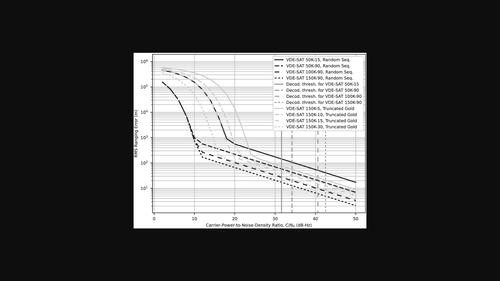当前位置:
X-MOL 学术
›
Int. J. Satell. Commun. Netw.
›
论文详情
Our official English website, www.x-mol.net, welcomes your
feedback! (Note: you will need to create a separate account there.)
Performance bounds for VDE-SAT R-Mode
International Journal of Satellite Communications and Networking ( IF 0.9 ) Pub Date : 2021-09-19 , DOI: 10.1002/sat.1429 Jan Šafář 1 , Alan Grant 1 , Martin Bransby 1
International Journal of Satellite Communications and Networking ( IF 0.9 ) Pub Date : 2021-09-19 , DOI: 10.1002/sat.1429 Jan Šafář 1 , Alan Grant 1 , Martin Bransby 1
Affiliation

|
There has been growing interest within the satellite navigation community in the possibility of delivering positioning and timing services from existing or emerging constellations of Low-Earth Orbit communication satellites. At the same time, the international maritime community has been investigating the potential use of communication signals transmitted from shore-based stations for positioning—a concept commonly referred to as ‘ranging mode’, or R-Mode. The driving force for these developments is the desire to reduce the reliance on traditional Global Navigation Satellite Systems (GNSS). One of the technologies being considered for use in R-Mode is the evolution of the Automatic Identification System (AIS) known as the Very High Frequency Data Exchange System (VDES). VDES has a terrestrial and a satellite component. The feasibility of using terrestrial VDES transmissions for ranging was studied in a previous publication by the authors. This paper builds on the previous study and extends its results to the satellite component of VDES. Statistical bounds on the ranging error are derived for all downlink waveforms currently being considered for use in satellite VDES and for several custom-designed transmission formats. The analysis supports the feasibility of using both the existing and custom waveforms in ranging applications and points to related trade-offs that will need to be considered in the design of satellite VDES R-Mode systems.
中文翻译:

VDE-SAT R 模式的性能界限
卫星导航界对从现有或新兴的低地球轨道通信卫星星座提供定位和授时服务的可能性越来越感兴趣。与此同时,国际海事界一直在研究利用岸基站传输的通信信号进行定位的潜在用途——这一概念通常被称为“测距模式”或 R 模式。这些发展的驱动力是希望减少对传统全球导航卫星系统 (GNSS) 的依赖。正在考虑在 R 模式中使用的技术之一是称为甚高频数据交换系统 (VDES) 的自动识别系统 (AIS) 的发展。VDES 具有地面和卫星组件。作者在之前的出版物中研究了使用地面 VDES 传输进行测距的可行性。本文以先前的研究为基础,并将其结果扩展到 VDES 的卫星部分。测距误差的统计范围是针对目前考虑用于卫星 VDES 的所有下行链路波形和几种定制设计的传输格式得出的。该分析支持在测距应用中同时使用现有波形和自定义波形的可行性,并指出在设计卫星 VDES R-Mode 系统时需要考虑的相关权衡。测距误差的统计范围是针对目前考虑用于卫星 VDES 的所有下行链路波形和几种定制设计的传输格式得出的。该分析支持在测距应用中同时使用现有波形和自定义波形的可行性,并指出在设计卫星 VDES R-Mode 系统时需要考虑的相关权衡。测距误差的统计范围是针对目前考虑用于卫星 VDES 的所有下行链路波形和几种定制设计的传输格式得出的。该分析支持在测距应用中同时使用现有波形和自定义波形的可行性,并指出在设计卫星 VDES R-Mode 系统时需要考虑的相关权衡。
更新日期:2021-09-19
中文翻译:

VDE-SAT R 模式的性能界限
卫星导航界对从现有或新兴的低地球轨道通信卫星星座提供定位和授时服务的可能性越来越感兴趣。与此同时,国际海事界一直在研究利用岸基站传输的通信信号进行定位的潜在用途——这一概念通常被称为“测距模式”或 R 模式。这些发展的驱动力是希望减少对传统全球导航卫星系统 (GNSS) 的依赖。正在考虑在 R 模式中使用的技术之一是称为甚高频数据交换系统 (VDES) 的自动识别系统 (AIS) 的发展。VDES 具有地面和卫星组件。作者在之前的出版物中研究了使用地面 VDES 传输进行测距的可行性。本文以先前的研究为基础,并将其结果扩展到 VDES 的卫星部分。测距误差的统计范围是针对目前考虑用于卫星 VDES 的所有下行链路波形和几种定制设计的传输格式得出的。该分析支持在测距应用中同时使用现有波形和自定义波形的可行性,并指出在设计卫星 VDES R-Mode 系统时需要考虑的相关权衡。测距误差的统计范围是针对目前考虑用于卫星 VDES 的所有下行链路波形和几种定制设计的传输格式得出的。该分析支持在测距应用中同时使用现有波形和自定义波形的可行性,并指出在设计卫星 VDES R-Mode 系统时需要考虑的相关权衡。测距误差的统计范围是针对目前考虑用于卫星 VDES 的所有下行链路波形和几种定制设计的传输格式得出的。该分析支持在测距应用中同时使用现有波形和自定义波形的可行性,并指出在设计卫星 VDES R-Mode 系统时需要考虑的相关权衡。







































 京公网安备 11010802027423号
京公网安备 11010802027423号